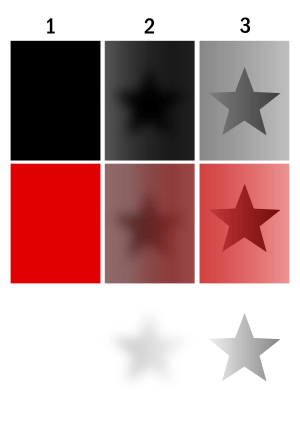Opacity (optics) facts for kids
Opacity is a way to describe how much something blocks light or other types of radiation. If something is opaque, it means light cannot pass through it. Think of it like a wall that stops light from going to the other side.
An opaque object is different from something transparent (like clear glass, which lets all light through) or translucent (like frosted glass, which lets some light through but you can't see clearly). When light hits an opaque object, it can be reflected (bounce off), absorbed (taken in), or scattered (sent in many different directions). An opaque object doesn't let any light pass through it.
Things like a mirror or carbon black (like soot) are opaque. Opacity can also depend on the type of light. For example, some types of glass are clear for the light we see, but they block ultraviolet light.
Contents
What Makes Something Opaque?
Different things can make an object opaque. These include:
- Absorption: The object soaks up the light energy.
- Reflection: The light bounces off the object's surface. This can be a clear reflection (like a mirror) or a scattered reflection (like light off a white wall).
- Scattering: The light hits tiny particles inside the object and gets sent in many different directions, so it can't pass straight through.
Where Does the Word "Opaque" Come From?
The word "opaque" comes from the Latin word opacus, which means "darkened." It has been used in English since the Middle Ages.
Radiopacity: Blocking X-rays
What is Radiopacity?
Radiopacity is a special type of opacity that describes how well something blocks X-rays. In modern medicine, doctors use radiopaque substances because they stop X-rays from passing through.
How is Radiopacity Used in Medicine?
Radiopaque materials are very important for X-ray imaging. Doctors can use special liquids called contrast media that are radiopaque. These liquids can be put into the bloodstream, the stomach, or other parts of the body. When X-rays are taken, the contrast media show up brightly on the image. This helps doctors see organs, blood vessels, or other areas that are usually hard to see on a regular X-ray or CT scan.
Radiopacity is also important when designing medical tools like guidewires or stents. These tools are used inside the body during medical procedures. Because they are radiopaque, doctors can see them clearly on X-ray screens. This helps them guide the tools to the right place during an operation.
See also
 In Spanish: Opacidad para niños
In Spanish: Opacidad para niños
- Absorption (electromagnetic radiation)
- Reflection (physics)
- Scattering theory
- Transparency and translucency


